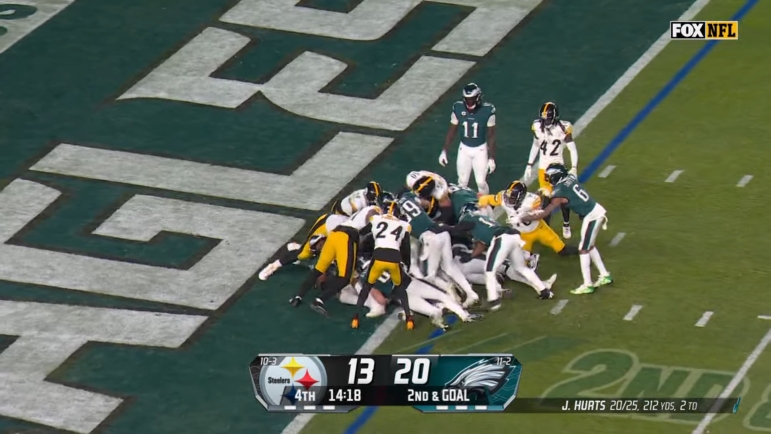If there is one play that the Philadelphia Eagles are known for, it is the Tush Push — sometimes called the Brotherly Shove. It’s a controversial play that involves assisting the runner and basically forming a rugby scrum to push the pile in short-yardage situations.
They’ve become so well known for the play that it’s become an annual talking point when rule changes are proposed to the NFL’s competition committee. There have been multiple discussions about outlawing the play. Mike Tomlin sits on that competition committee, so he should be well aware of the specifics.
According to Beanie Bishop Jr., the Steelers didn’t really focus on stopping the Tush Push before they played the Eagles.
“We didn’t even really talk about it that much honestly because we didn’t really prepare for them to be in those kind of situations,” Bishop said via the Christian Kuntz podcast on YouTube. ” Obviously on film they don’t really have that many third and shorts and stuff like that. They usually do a good job on first and second down, so you don’t really talk about that kind of stuff.”
This is in line with what Tomlin told Bob Labriola via Steelers.com before the game. The best way to limit the Tush Push is by avoiding it altogether.
Teams only have so much practice time, and there’s probably time better spent on other aspects of the game. The Eagles have a very good team on both sides of the ball and focusing on stopping their offensive game plan rather than just one play that may or may not happen makes sense. The only issue is the statistics don’t really bear out Bishop’s claim.
The Eagles find themselves in short-yardage situations on third or fourth down at an extremely high rate. They’ve had 39 opportunities this year with one yard to go. That is the second most in the league behind the Kansas City Chiefs.
The Tush Push works very well, and it often gets talked about during rule change proposal time because of how unstoppable it is. There really isn’t a great solution at stopping the play.
“I think it’s honestly hard for guys to stop that,” Bishop said. “It usually has to be, it’s usually a guy that jumps over the top and snatches the quarterback, snatches his upper body.”
It’s also a notoriously hard play to simulate in practice. Teams aren’t going to have their practice-squad players getting low and diving at knees of the starting defense just to work on stopping the Tush Push. It’s too risky for a play the defense might only see a couple times throughout the game.
The Steelers ended up seeing it four times. The Eagles converted three of those four attempts, and the failed attempt was immediately followed by a successful attempt near the goal line for a touchdown.
In the end, they didn’t do a great job at avoiding the Tush Push and got in far too many short-yardage situations. That’s one of the big reasons why the Eagles possessed the ball for nearly 40 minutes and ran 77 plays on offense.








